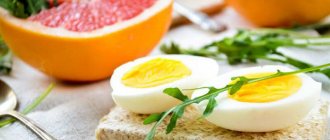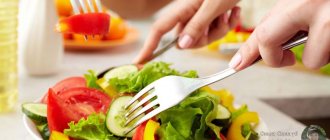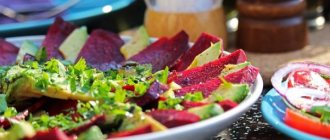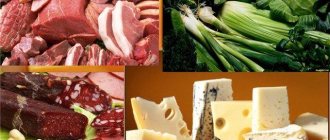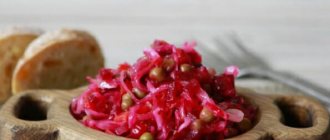Simple rules for being slim
The basics of healthy eating remain the same regardless of whether you decide to lose weight out of choice or for health reasons.
This process must begin by reviewing your own rhythm and way of eating.
Dietary nutrition for proper and healthy weight loss is developed individually
The basic rules of harmony will help with this:
- Eating vegetables and fruits daily will replenish missing minerals.
- Replacing animal fats with vegetable fats will reduce the amount of fat.
- You cannot completely exclude meat and fish from your diet, but it is recommended to replace it with lean, low-fat types.
- Natural dairy and fermented milk products must be included in the daily diet.
- It is necessary to monitor not only the portions of food, but also the amount of liquid you drink to avoid disturbing the water balance. It is best to exclude canned juices and carbonated drinks, replacing them with clean, still water.
- The best meal plan for every day consists of 5 meals: breakfast, snack, lunch, afternoon snack, dinner.
- Try to diversify your menu every day. Creating a different menu for each week will help avoid routine and addiction.
Creating an individual healthy diet menu can be difficult.
In this case, popular diets for quick and affordable weight loss come to the rescue.
Preparation
It is not easy to immediately switch to fractional meals, because the stomach is greatly enlarged, and a portion of 200 grams is not perceived by him as complete. Over the course of a week, it is recommended to gradually reduce the amount of food you eat, learn to plan meal times, and wean yourself off snacking and eating on the run. If you urgently need to lose weight before starting a diet, you can arrange a fasting day on apples or kefir, which will reduce the volume of your stomach; on the second day you can begin to adhere to the serving size of 200 grams.
Prepare yourself with food containers, a notepad and a pen in advance to record your meal times. This will reduce the risk of failure. If you can't eat at home, take food in containers with you. When visiting cafes and restaurants, order main courses and refuse salads and drinks. Since tablespoons have different shapes and sizes, their volume can vary from 10 to 20 ml. Similarly, difficulties arise with measuring dense, heterogeneous dishes - one spoon of stew or pilaf can weigh 15-25 g.
- Increased lip volume
- Treatment of vegetative-vascular dystonia
- Pain in the buttocks
Nutritionists recommend using kitchen scales - take 150-200 g servings, regardless of the volume of food. Another way out is to use a cut glass - eat half of this volume at a time. Another option is to use the size of your palm - a calm state of the stomach is equal to a clenched fist, and you should not stretch it.
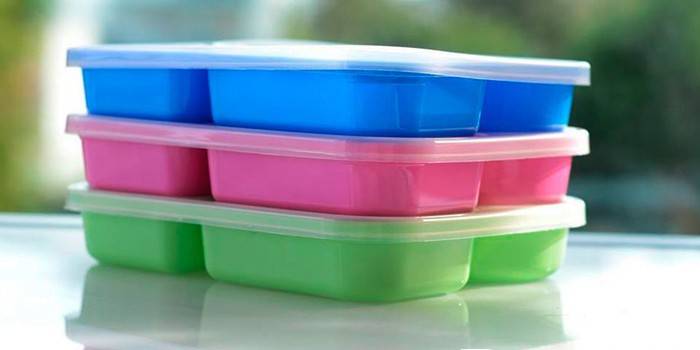
How to lose weight inexpensively. The most popular diets
With so many different diets out there, choosing a diet that's right for you can be difficult.

Products used to prepare dietary dishes must be accessible
It is recommended to choose a diet not only according to taste preferences, but also according to the proposed menu.
Products used to prepare dietary dishes should be accessible, and the dishes themselves should take a minimum of time to prepare.
Among the most popular and affordable diets, it is worth highlighting the following:
- kefir;
- Kremlin;
- Dukan;
- rice;
- apple;
- buckwheat;
- vegetable;
- protein and egg.
The mono-diet, although considered one of the most popular, is not suitable for long-term nutrition.
Such a diet will quickly get boring, and besides, the body has the ability to get used to the same food, which has a detrimental effect on the process of losing weight. Therefore, such a diet is an emergency way to lose weight and unload the body.
Buckwheat diet
A subtype of mono-diet with various variations. It implies a monotonous diet, the basis of which is buckwheat porridge, prepared in a special way.
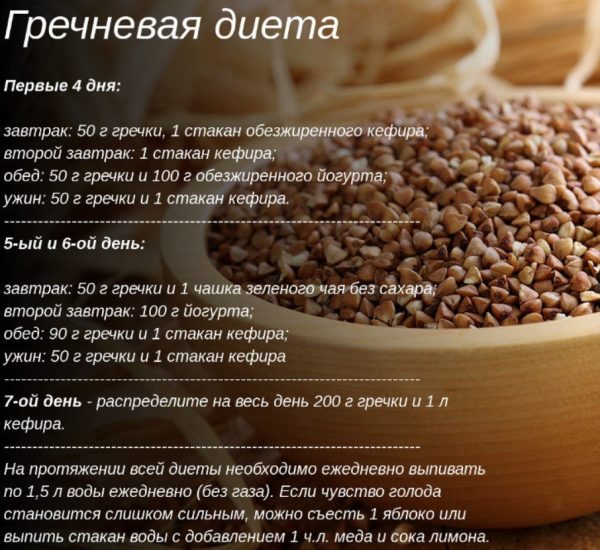
Buckwheat diet
For dietary nutrition, buckwheat cannot be boiled or stewed; it is poured with boiled water or milk and steamed.
Usually it is designed for 1-2 weeks, but if the menu is diversified with other products, it can be extended for 1 week. During the specified period, you can get rid of 2-8 kg, depending on the initial weight.
Despite the strictness and monotony of the buckwheat diet, it has a number of significant advantages:
- cleanses the body of waste and toxins;
- is characterized by its low cost;
- does not take much time to cook;
- helps saturate the body with iron, calcium, fluorine and other elements;
- gives a feeling of fullness for a long time;
- The fiber contained in the cereal cleanses the intestines and stabilizes its functioning.
Be sure to read: Proper nutrition, where to start: how to switch and not break, menu, portion sizes
Such a mono-diet will be a risky choice for people with health problems; it can provoke increased nervous excitement and weakness.
Therefore, it is contraindicated for people with poor health and nutritional diseases.
Kefir diet
Strict fasting diet, designed for 4-7 days. Low-fat kefir in combination with other products becomes the main product of the weekly diet.
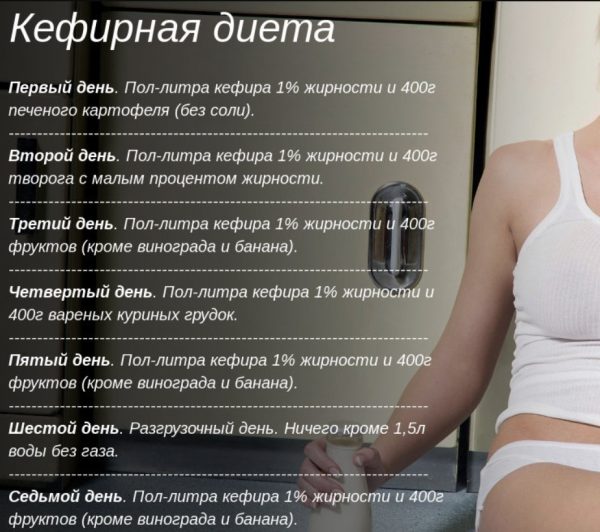
Kefir diet
The daily ration on the diet is 1500 ml of kefir with 1-1.5% fat content and 100-400 g of additional product, while the daily ration should be divided into 6 meals exactly by the hour.
As additional products you can use:
- greenery;
- cucumbers;
- potato;
- bran;
- cottage cheese;
- chicken meat;
- fruits (except bananas and grapes);
- eggs.
In a week of such strict nutrition, you can lose up to 8 kg of excess weight if you strictly follow the nutritional rules.
The kefir diet menu can be different for every day or crossover, which means eating the same products for 2 days.
Rice diet
A type of express diet, the main product of which is rice.
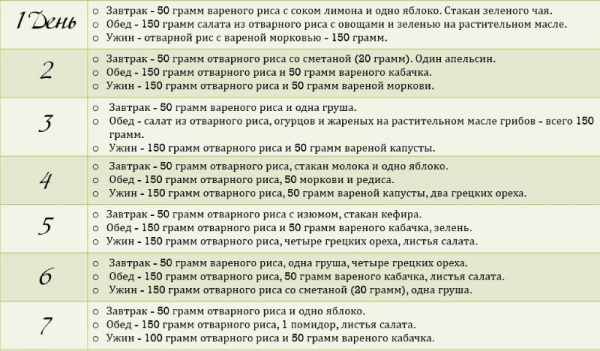
Rice diet
It is preferable to use different varieties of rice: brown, red, steamed white.
The mono-diet involves 2-3 meals of rice, steamed or grilled without oil.
Rice is rich in vitamins and has a natural ability to absorb water, so it effectively cleanses the body and eliminates fluid stagnation and swelling.
Advice! To double the benefits and release nutritional enzymes, it is recommended to soak the rice in water overnight before eating.
Despite the benefits, you should be careful with this diet, since excess consumption of rice can cause the accumulation of bile in the body and the formation of gallstones.
Apple diet
There are two types of apple diet: a strict diet of only apples (up to 1.5 kg per day) and a diet that includes other foods.
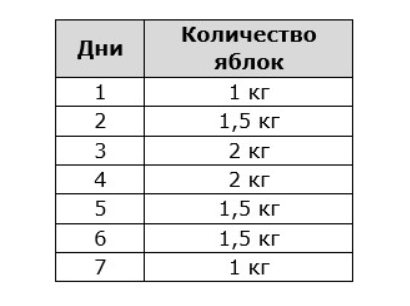
The first version of the apple diet: only a few reach the finals
The second option is more popular because it is less harsh and has a greater variety of dishes.
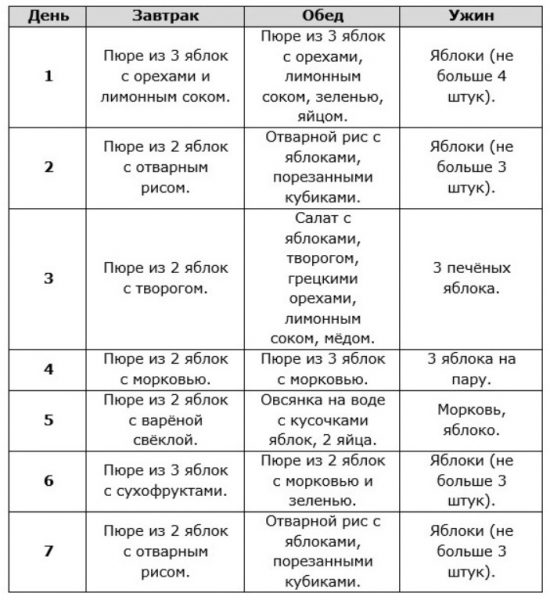
The second version of the apple diet
This diet is designed for 3-7 days and allows you to add not only apples to your daily diet, but also rye crackers, honey, cereals, dairy products, meat and fish.
Note! Frequent consumption of apples can cause an excess of carbohydrates and a lack of proteins. This provokes increased nervous excitability and can lead to stress.
During the diet, you are allowed to drink still water in unlimited quantities, but not less than 1.5 liters. At the end of the apple diet, you can get rid of 4-7 kg.
Banana diet
This diet involves eating at least 3-4 bananas every day in combination with dairy and fermented milk products strictly according to the clock.
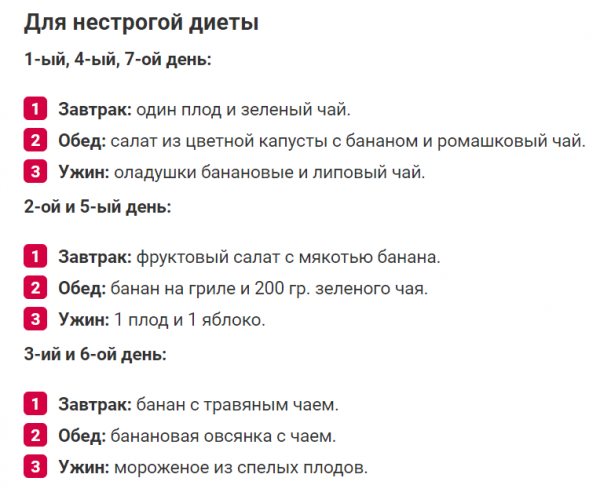
Banana diet
Gives a feeling of satiety, so it is easily tolerated by the body. During this diet, you can lose up to 6 kg of excess weight.
The disadvantage of the diet is the scarcity of the diet and strictly limited portions, which is why it is not recommended for people with chronic diseases of the gastrointestinal tract.
Vegetable diet
The most optimal dietary option that is suitable for a long time.
The main advantage of a vegetable diet is an unlimited choice of dishes and a wide variety of products, which will avoid addiction, apathy and weight stagnation.
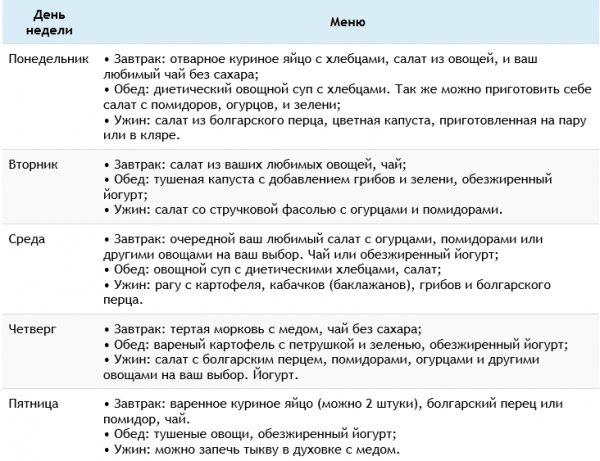
Vegetable diet
A vegetable diet involves daily consumption of fresh vegetables, berries and fruits in quantities of up to 1.5 kg, while foods are allowed to be boiled, steamed or grilled.
Be sure to read: Diet for teenagers of different ages: rules, allowed and prohibited foods, weekly menu
Sample vegetable diet menu for every day:
- Breakfast: vegetable or fruit salad with yogurt, rye bread, apple, juice or tea without sugar.
- Lunch: cabbage or celery soup, boiled potatoes, tomato and cucumber salad dressed with vegetable oil, a slice of rye bread, juice.
- Afternoon snack: apple, red bell pepper or rye cracker with kefir.
- Dinner: stewed vegetables with lean fish, a piece of diet cheese, crackers, a glass of dried fruit compote.
Rules
When following the 200 gram diet, you must adhere to certain rules. This guarantees success in losing weight. Recommendations:
- Five tablespoons of food are taken at intervals of three hours. After two weeks, you can increase the period of time between meals to 4 hours, but no more.
- Five tablespoons equals 200 grams or 15 teaspoons.
- After eating, you can drink tea or water 40 minutes later; liquids are prohibited during meals.
- Tea and coffee are taken without sugar.
- Sweet carbonated drinks and compotes with sugar are prohibited, but herbal infusions, compotes with natural fruits without sugar or with natural sweeteners, and a chicory-based drink are allowed.
- Servings need to be served in tablespoons, and you need to eat in teaspoons - this way food is absorbed better, and the brain quickly receives a signal of saturation.
- At first you can eat the same dishes, but after a week you should switch to healthy and proper nutrition.
- All types of meat, poultry, fish, and dairy products are allowed. As for carbohydrates, you can eat whole grain cereals; restrictions apply to baked goods, sweets and confectionery desserts. Fats are allowed to include nuts, vegetable oils, and fatty fish. Fried food is prohibited. It is better to bake vegetables or eat them raw.
- Nutritionists advise eating a varied and nutritious diet, it is better to cook simple meals, and you need to take a complex of vitamins separately. You should drink at least 1.5 liters of clean water per day.
- While on a diet, avoid industrial sauces and hot spices - they increase your appetite, and this increases the risk of failure. Fast food is similarly prohibited, even in the specified dosage of 200 grams.
- Meals occur every three hours, with a total of 4-6 meals per day. The last meal in the evening is taken 2-2.5 hours before bedtime. It is better to choose light snacks that do not weigh down your stomach.
When following a diet, you need to pay attention to first courses and sweets. Recommendations for their use:
- Five spoons of soup will not satisfy your hunger, so they do this: measure out 200 grams of grounds and mix it with 200 ml of broth. This makes a standard portion.
- On a diet, you can eat pastries, cakes, pastries or chocolate, but as a supplement and not as a main meal. Otherwise, there is a risk of gaining weight - servings of 150 g of chocolate six times a day will amount to 3000 kcal calories, which is unacceptable on a diet. Sweets are accepted in quantities of no more than 150 g at a time, no more than once a day, no later than 16.00.
- A glass of sweet juice is equivalent to a full meal.

Example of a daily diet plan for a week
The optimal dietary intake is compiled individually, based on the needs and preferences of the person.
An approximate weekly food menu might look like this:
| Day of the week | Menu |
| Monday | Breakfast: rye cracker, a piece of cheese, vegetables, green tea without sugar Lunch: boiled chicken fillet, vegetable salad, crackers. Afternoon snack: apple, glass of kefir. Dinner: vegetable puree soup, carrots, tea |
| Tuesday | Breakfast: fruit salad, herbal tea. Lunch: baked vegetables with fish, rye crackers, juice. Afternoon snack: kefir with bran or dried fruits. Dinner: meat with steamed vegetables (no potatoes), a piece of cheese, tea |
| Wednesday | Breakfast: a glass of kefir, vegetable salad, orange. Lunch: steamed chicken meatballs, tomato and cucumber salad, tea. Afternoon snack: a glass of juice and any vegetable. Dinner: whole grain pasta, boiled chicken fillet, dried fruit compote |
| Thursday | Breakfast: chicory drink, crackers, honey and dried fruits. Lunch: vegetable salad with crackers and bran, low-fat cheese, tea. Afternoon snack: a glass of yoghurt with fruit. Dinner: baked eggplants with fish and herbs, crackers, juice |
| Friday | Breakfast: cottage cheese casserole with honey, orange juice. Lunch: pumpkin soup with sesame seeds, chicken fillet, cheese. Afternoon snack: sandwich with crackers and cheese, kefir. Dinner: chicken baked with vegetables and sesame seeds, tea without sugar |
| Saturday | Breakfast: oatmeal with milk, apple and honey, yogurt. Lunch: baked fish with rice, vegetable salad, juice. Afternoon snack: yogurt with bran and pieces of fruit. Dinner: boiled potatoes with fish and beans, rye crackers, tea |
| Resurrection | Breakfast: toast with egg and cheese, tomato, carrots, juice. Lunch: steamed veal with vegetables and herbs, kefir. Afternoon snack: cheese with tomato and vegetable oil. Dinner: stuffed potatoes with cottage cheese, fish and herbs, dried fruit compote |
Should you go on a diet?
Diets are used when you need to quickly lose weight or have health problems (diabetes, high cholesterol, etc.). In other cases, severe dietary restrictions can lead to adverse consequences.
- Stress. Eating is also a way to relax. When there is not enough food, thoughts are occupied only with this, which leads to irritability and stress.
- Decreased performance due to lack of nutrients entering the brain.
- Breakdowns leading to weight gain. It works like this: after a long period of fasting, the body tries to store as much fat as possible in case of another calorie shortage. This happens especially quickly when, after a diet, a person immediately rushes to junk food in large quantities.
Therefore, diets are not always beneficial. The best way out would be to completely review your menu, not for 1 week or month, but for life. This does not imply constant restrictions, but a smooth transition to proper nutrition, in which you can also find a lot of pleasant things.
In the principles of PP there is no feeling of hunger or refusal of all food joys. This approach gets you into shape slowly and with health benefits. You can also increase your level of physical activity: start jogging, cycling, going to the gym or swimming pool. Diets remain a last resort for quick, but not always lasting results.
What exactly can you eat and what can’t you eat?
When following any diet, there is a list of foods that are prohibited for consumption and those that should be on the menu.
The basis of the diet should be: vegetables and fruits, herbs, dried fruits, cheese, low-fat cottage cheese and fermented milk products, cereals and cereals.
It is recommended to reduce the amount of sugar and salt consumed, and also avoid the following harmful foods:
- spices;
- soda, chips;
- confectionery, sweets and baked goods;
- potato;
- chocolate;
- butter;
- smoked and canned products;
- meat and fish with a high fat content.
Meanwhile, it is not recommended to completely exclude fish and meat, since they contain a large amount of valuable vitamins and proteins.
It is best to replace fatty varieties with low-fat beef, chicken, cod, and trout.
Planning a Healthy Meal Menu
Reviewing your diet means changing your lifestyle, and they require creating a plan that you stick to in the future.
- Daily regime. People haven't gotten up and gone to bed with the sun for a long time. A fairly high percentage of men and women work at night. There are also “owls” and “larks”. These factors are fundamental in the breakfast and dinner schedule.
- Diet. Before you create a proper nutrition menu, you need to decide on your goal. There is one diet for weight correction, and another for maintaining health. If you need to lose more than 5 kg, the menu is limited, but not sharply.
- Visual plan. The diet is scheduled for the week by the hour. It is more convenient to enter data into a table. This will allow you to monitor quality and quantity. The easiest way is to download a special application.
- Smooth transition. Changes are carried out smoothly. Sharp calorie restrictions often give the opposite result. When there is a deficiency of nutrients, the body makes reserves in the form of fat deposits. In the first week, it is enough to exclude harmful foods.
Diet food for weight loss: inexpensive menu for 10 days
In order for the diet to be as healthy as possible and suit you, it is recommended that you do not use ready-made menu options, but create it yourself.
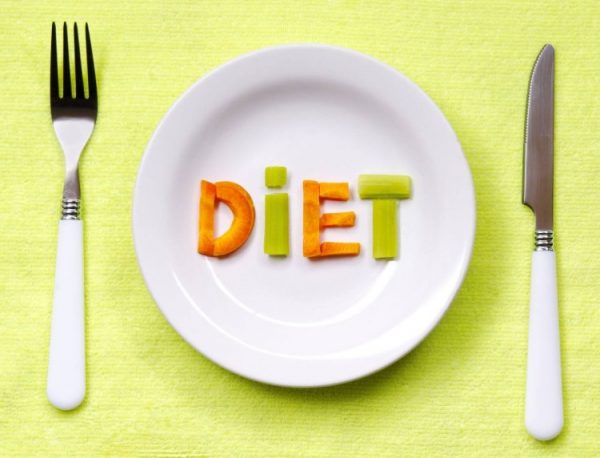
Choose from the acceptable products those that you like
To correctly create a menu for weight loss for 10 days, you must follow the following rules:
- Choose among the acceptable products those that suit your taste.
- The daily menu must include at least 4 meals: breakfast, lunch, afternoon snack and dinner.
- You can search for recipes on the Internet based on the list of selected products and availability.
- Distribute meals evenly across days of the week for 10 days.
- Avoid repeating the same dishes in your diet.
- If recipes contain prohibited foods, replace them with healthy ones.
All dishes should be accessible and inexpensive, and also take a minimum of time to prepare.
Quitting the diet
A low-carbohydrate diet is effective and affordable, but after 2 months you need to return to your normal diet. The exit is done gradually in order to minimize stress on the body and not regain previously lost kilograms.

Return to normal diet in 3-4 weeks:
- in the first and second weeks, the amount of fruits and vegetables (not containing starch) increases;
- third week – reduction of protein foods by adding cereals;
- the number of calories is also increasing every day.
What problems might you encounter?
In the process of losing weight, some difficulties may arise that slow down weight loss and bring additional discomfort.
The most common include:
- uncontrollable hunger;
- lack of vitamins;
- depression and stress;
- circles under the eyes and skin problems;
- water balance disturbance.
All of the above problems arise as a result of an incorrectly selected diet, too strict food restriction and can be corrected by balancing the diet and taking enough water and a vitamin-mineral complex.
Uncontrollable snacking
Uncontrolled snacking on a diet occurs most often due to a psychological imbalance rather than a physiological need for food.
The body is accustomed to receiving as much food as it wants. In order not to gain additional weight due to frequent snacking, it is important to make them as healthy as possible by replacing unhealthy foods with dietary ones.
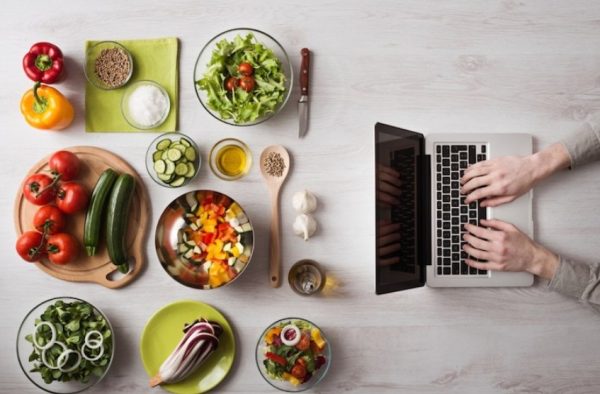
An occasional snack of fresh fruits, berries, vegetables and a glass of kefir will help saturate the body.
A periodic snack of fresh fruits, berries, vegetables and a glass of kefir will help saturate the body with vitamins and improve natural metabolism.
Want to replace dishes? It's OK!
If a dish on the menu doesn’t suit you, you can easily replace it with your own recipe using healthy ingredients.
To ensure that such a replacement does not affect the weight loss process, it is important to adhere to the rules of proper nutrition and the list of preferred foods.
Important! It is recommended to adhere to a nutrition plan if we are talking about a mono-diet. Replacing buckwheat porridge on a buckwheat diet will have a significant impact on the result of weight loss and may worsen it.
Violation of the established diet
A weight loss diet imposes certain restrictions on your diet and diet.
Failure to comply with restrictions can affect not only the process of losing weight, but also the functioning of the entire body: disrupt the water balance, intestinal microflora, and provoke skin rashes.
Eating prohibited foods can negate all a person’s attempts to lose weight and lead to weight gain.
Basic rules of a low-carb diet
The method involves consuming a minimum portion of carbohydrates sufficient to maintain the functioning of the body. For women, 2 grams per kilogram of weight is required, for men - 3 g. If the daily intake is 120-150 g, then for weight loss the figure gradually and gradually decreases to 50-70 g per day. Protein food becomes a substitute source of energy and maintains muscle tone.
A low carbohydrate diet lowers insulin levels, which suppresses appetite. Ketone bodies, which come from animal and vegetable proteins and fats, block the flow of information about the feeling of hunger.
Following some principles will help you achieve your goals:
- exclude products with a high glycemic index from the diet;
- take additional vitamins and minerals;
- The preferred cooking method is stewing, boiling, grilling, steaming. Fry the ingredients without adding oil or with a small amount;
- do not skip meals or reduce calories;
- Intake complex carbohydrates in the first half and before training, in the second - protein foods;
- be sure to have breakfast;
- maintain a drinking regime: at least 2 liters of clean liquid.
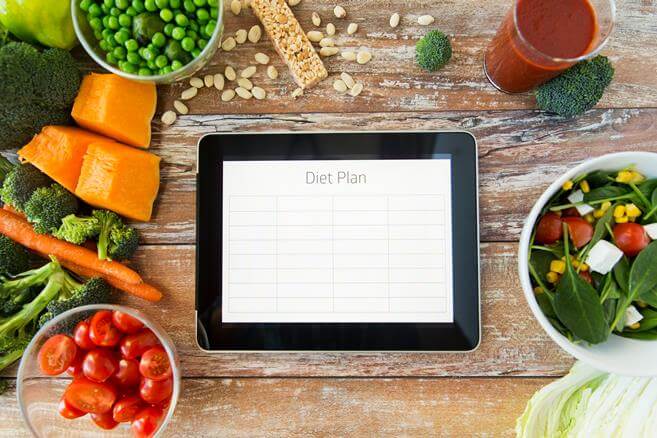
Do not forget that correct calculation of the daily energy requirement when losing weight is the first step before starting any diet.
Recommendations from nutritionists: how not to break your diet
The menu for a week for weight loss has been drawn up, but another problem arises - how to stick to this menu? Professionals note that in this situation it is not just a matter of willpower.
There are several recommendations from nutritionists and psychologists on how not to relapse:
- Boredom is the enemy. It happens that a person sits at home and has nothing to do with himself. Then the legs naturally carry you to the refrigerator, because food, especially during a diet, brings pleasure, and therefore is a kind of entertainment. You need to make your days as eventful as possible: walks, work, training courses - anything that will distract you from thoughts about delicious foods.
- Spending time outside. First, it reduces stress. Secondly, it is a little more difficult to get food outside the home: to do this, you at least need to go to the store (this temptation can be avoided by carrying a minimum amount of money with you, for example, for travel).
- Purchases. You can’t reward yourself with food, but you can and should give yourself small gifts in the form of clothes or accessories. It lifts your spirits and serves as a leisure activity.

- It is not recommended to watch movies and videos or read while eating. It has long been established that in such cases a person gets carried away and eats more than planned.
- Preparation. You don’t need to go on a strict diet right away, especially if you haven’t had any experience before. You can start with a couple of fasting days or a day without sweets to prepare the body.
- Motivation. You should set a clear goal for yourself and know that every day of the diet is a step towards it, and also understand why achieving the goal is necessary (look good / arouse someone’s interest / fit into your favorite dress). Nutritionists say that some of their patients made bets with friends or hung photos in the house of how they wanted and didn’t want to look as motivation.
- Maintaining a calendar. Each day that passes without disruption can be crossed out with a bright color. This visualization method helps many girls.
- Nothing extra in the refrigerator. If there is no supply of chocolates and ice cream at home, then the temptation will disappear.
- Tell me about your diet. Psychologists and nutritionists recommend telling friends and family about the weight loss process. The more people learn about the diet, the more incentive there will be to stick to it. And loved ones will be able to provide moral support or also refuse some products.
- Using small dishes . A piece seems larger when served on a small plate, when half-empty dishes will only cause a feeling of dissatisfaction. This is how you can deceive hunger.
Among the ways to lose weight, a diet of rational, balanced nutrition with calorie counting for every day of the week is one of the most effective options for losing excess weight. It is not difficult to maintain this period of time if you follow the recommendations and create an interesting menu with tasty low-calorie dishes.
Article design: Vladimir the Great
Low-calorie healthy foods
The weekly menu for weight loss should include mainly low-calorie foods.
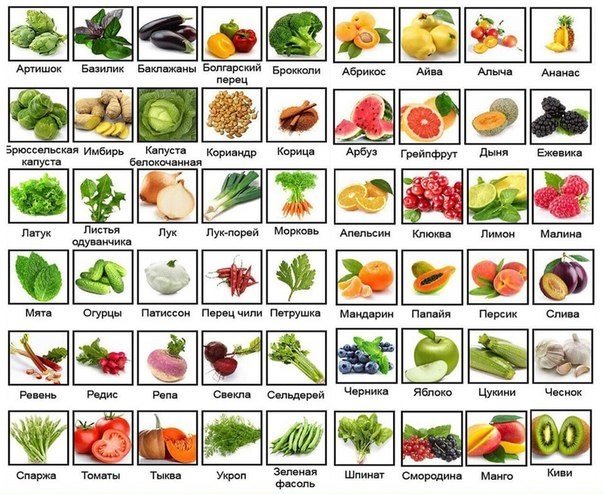
These include:
- water and green tea - 0 kcal g;
- lettuce, dill, parsley - 12-13 kcal/100 g;
- tomatoes - 14 kcal/100 g;
- cucumbers - 13-15 kcal/100 g;
- cauliflower, green onions - 18 kcal/100 g;
- sorrel - 17 kcal/100 g;
- radishes - 19 kcal/100 g;
- plums, apples, blueberries, peaches, gooseberries - 44-45 kcal/100 g;
- Brussels sprouts - 12 kcal/100 g;
- white cabbage - 23 kcal/100 g;
- broccoli - 33 kcal/100 g;
- raspberries - 41 kcal/100 g;
- grapefruit - 29 kcal/100 g;
- watermelon - 30 kcal/100 g;
- turnips, mushrooms, mushroom/chicken broth - 30 kcal/100 g;
- green peas - 55 kcal/100 g;
- celery - 16 kcal/100 g;
- chicken egg white - 52 kcal/100 g;
- beef (not fried) - 180 kcal/100 g;
- veal (not fried) - 90 kcal/100 g;
- turkey, rabbit - 198 kcal/100 g;
- chicken - 165 kcal/100 g;
- low-fat kefir - 30 kcal/100 g;
- milk 0.5% - 36 kcal/100 g;
- low-fat cottage cheese - 50-70 kcal/100 g (depending on the specifics of production);
- yogurt 1.5% - 50 kcal/100 g;
- rice and buckwheat – 335 kcal/100g;
- flounder - 86 kcal/100 g;
- trout - 160 kcal/100 g;
- salmon - 200 kcal/100 g;
- muesli, flakes - 320-360 kcal/100 g.
And although low-calorie foods are considered to be those containing less than 1 kcal per 1 g, you cannot get by with them alone, so the list contains some cereals and protein foods that are allowed in small quantities during diets.
How many kilograms can you lose in a week?
By adhering to the 7-day menu described above, you can lose about 3 kg. This is confirmed by reviews of women who have tried the diet. If you eat according to the kefir economy menu, you can lose up to 5 kg - a very good result. More accurate numbers depend on the individual characteristics of the body and the percentage of fat. The more there is, the faster it burns.
You should not chase rapid weight loss. With a very strict diet and physical activity, you can reduce your weight by 10 kg in 7 days, but this will be classified as extreme weight loss that is dangerous to your health.
There is no guarantee that after such stress the fat will not return in even greater quantities. Normal weight loss is when you lose 1 kg per week (4 per month, respectively). For obese people, the norm may be 2 kg per week.

